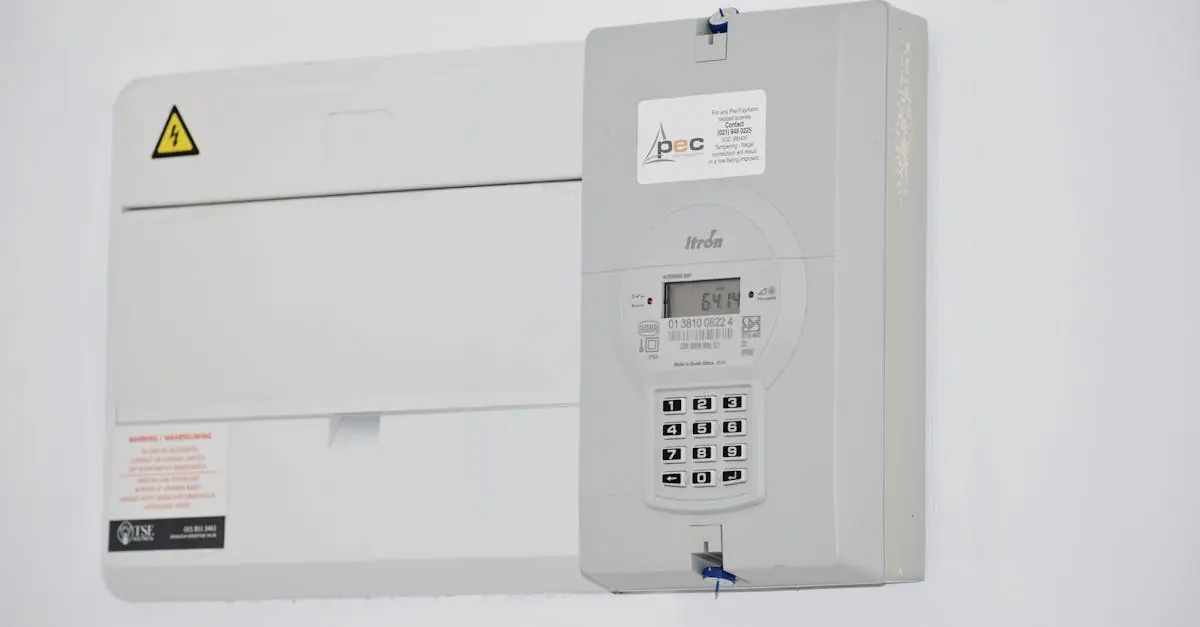Table of Contents
ToggleImagine a world where your home knows you better than your best friend. It adjusts the thermostat when you’re cold, dims the lights for movie night, and even reminds you to water that poor, neglected plant. Home automation isn’t just about convenience; it’s a game-changer for energy efficiency. By analyzing energy usage, homeowners can save money while reducing their carbon footprint.
Overview of Home Automation Energy Analysis
Home automation energy analysis involves assessing energy consumption patterns within automated systems. This examination helps identify areas where efficiency can improve, directly enhancing energy savings. Advanced monitoring tools facilitate tracking energy use in real-time, providing data-driven insights for homeowners.
Utilizing analytics, systems adjust settings based on occupancy and usage trends. Smart thermostats, for instance, adapt to homeowners’ schedules, optimizing heating and cooling when needed most. Data collected from devices assists individuals in understanding peak energy consumption times.
Automated lighting systems contribute by adjusting brightness according to natural light levels, eliminating unnecessary energy waste. Sensors detect occupancy, ensuring lights remain off in unoccupied spaces. These features significantly reduce overall energy expenditure.
Integration of renewable energy sources, such as solar panels, enhances home automation’s effectiveness. Homeowners can store excess energy generated during daylight hours for nighttime use, increasing sustainability. Data from solar panel systems enables users to monitor production and correlate it with household energy demands.
Home automation energy analytics also support decision-making by providing actionable recommendations. These insights may suggest upgrading appliances for increased efficiency or modifying behaviors to improve energy use. Through these analyses, homeowners realize both financial and environmental benefits, underscoring the importance of energy-conscious living.
Overall, leveraging home automation energy analysis fosters a more sustainable lifestyle while offering substantial cost savings. It empowers homeowners to make informed decisions based on accurate data, ultimately making their living spaces more efficient.
Benefits of Home Automation Energy Analysis
Home automation energy analysis provides homeowners with various advantages that enhance efficiency and sustainability.
Cost Savings
Cost savings represent a significant benefit of implementing energy analysis in smart homes. Homeowners experience reduced energy bills due to optimized energy consumption. Smart devices schedule usage during off-peak hours, leveraging lower electricity rates. Monitoring tools identify appliances that consume excessive energy, enabling targeted changes. These adjustments lead to an overall decrease in unnecessary consumption and increased savings each month. By investing in energy-efficient upgrades, homeowners can further reduce long-term expenses, ensuring a solid return on investment.
Environmental Impact
Environmental impact plays a crucial role in the benefits of home automation energy analysis. Lower energy consumption translates directly into reduced greenhouse gas emissions. Smart energy systems adjust usage based on real-time data, minimizing waste and promoting sustainable living. Integration of renewable energy sources, such as solar panels, allows homeowners to harness clean energy effectively. This alignment with eco-friendly practices not only meets modern sustainability goals but also fosters a healthier planet. Home automation energy analytics ultimately empowers individuals to contribute positively to the environment through informed energy management strategies.
Key Components of Home Automation Systems
Home automation systems integrate various components to optimize energy usage. Understanding these key elements enhances efficiency and effectiveness for homeowners.
Smart Meters
Smart meters provide real-time insights into energy consumption. They enable homeowners to track usage patterns throughout the day. Data collected allows for more accurate billing, eliminating estimated charges. These devices often connect to home networks, facilitating control via smartphone or tablet. Homeowners can receive alerts about high usage, encouraging proactive management of energy consumption.
Energy Monitoring Devices
Energy monitoring devices play a crucial role in assessing appliance efficiency. These tools measure energy consumption on an individual appliance level. Homeowners gain insights into which devices consume the most energy, helping prioritize upgrades or modifications. Remote monitoring features assist in managing energy use even while away from home. By evaluating the data, individuals can make informed decisions that lead to energy savings and lower utility bills.
Methods for Conducting Energy Analysis
Home automation energy analysis relies on various methods to assess and enhance energy efficiency. Understanding these methods helps homeowners optimize their automated systems.
Data Collection Techniques
Data collection includes several techniques that capture energy consumption patterns. Smart meters gather real-time information about total energy usage, providing homeowners with insights into their overall consumption. Wearable energy monitors track usage at the appliance level, allowing for granular analysis of individual device performance. Surveys and questionnaires can also collect information about household habits and preferences, offering contextual data to supplement electrical readings.
Analysis Tools and Software
Analysis tools and software play a critical role in interpreting collected data. Energy management systems aggregate data from various sources, displaying trends in an easy-to-understand format. Powerful analytics software evaluates energy usage against historical trends to identify patterns and anomalies. Many platforms offer dashboards that present information visually, making it easier for homeowners to understand their energy profile and detect inefficiencies.
Challenges in Home Automation Energy Analysis
Home automation energy analysis faces several challenges that can hinder its effectiveness. Data privacy concerns arise as homeowners may worry about the security of their personal information collected by smart devices. Ensuring robust protection of these data points is essential to gain user trust.
Integration issues also create barriers. Compatibility between different devices and systems affects seamless operation. Homeowners may struggle with connecting various smart devices from multiple manufacturers, complicating the overall energy management process.
Complexity of data can overwhelm users. Many homeowners lack the technical expertise necessary to interpret intricate energy data. Simplifying interfaces may improve usability, allowing homeowners to engage more readily with their energy profiles.
Cost implications present another challenge. Upgrading to advanced monitoring systems may require significant upfront investment. Homeowners often hesitate to make these investments without clear evidence of long-term financial benefits.
Interpreting consumption patterns proves difficult as well. Multiple variables such as time of day, usage habits, and seasonality influence energy consumption. Analyzing these factors necessitates sophisticated software tools that some users may find inaccessible.
Limited awareness about the benefits of energy analysis affects adoption rates. Many homeowners remain unaware of how automation can enhance their energy efficiency. Educating users about the potential savings may encourage greater utilization of these technologies.
Lastly, reliance on internet connectivity adds vulnerability. Disruptions in internet service may hinder real-time energy monitoring. Homeowners need reliable connectivity to harness the full benefits of their home automation systems.
Future Trends in Home Automation Energy Analysis
Emerging technologies are transforming home automation energy analysis. Innovations such as artificial intelligence enhance energy optimization by analyzing usage patterns more efficiently. Predictive algorithms leverage historical data to adjust energy consumption proactively, minimizing waste.
Integration with smart grids offers new opportunities for energy management. Homeowners can take advantage of dynamic pricing and energy availability by aligning their consumption with peak and off-peak periods. This capability leads to reduced energy costs and a more balanced load on the grid.
The adoption of machine learning plays a crucial role in improving energy efficiency. By continuously learning from user behavior, systems can automatically adapt settings for maximum savings. Home automation systems might soon include features that recommend upgrades based on real-time assessments of appliance efficiency.
Advanced data visualization tools make it easier for homeowners to understand their energy consumption. Intuitive dashboards present insights at a glance, highlighting inefficiencies or potential savings. Personalized recommendations empower users to make informed decisions on improving energy use.
Sustainability remains a key driver in home automation energy analysis. Increased focus on renewable energy sources encourages homeowners to invest in solar technology that integrates seamlessly with their automated systems. Energy storage solutions will likely become more affordable and widely adopted, allowing homeowners to harness solar energy for evening usage.
Finally, improving cybersecurity measures will become essential as technology advances. Protecting personal data collected by smart devices fosters user confidence and encourages wider adoption of home automation solutions. Enhanced security protocols, coupled with clear communication about data usage, can alleviate privacy concerns.
Home automation energy analysis stands as a pivotal tool for homeowners seeking to enhance both efficiency and sustainability. By leveraging smart technologies and data-driven insights, individuals can make informed decisions that lead to significant cost savings and reduced environmental impact.
The integration of advanced monitoring systems and renewable energy sources empowers homeowners to optimize their energy consumption effectively. As technology continues to evolve, embracing these innovations will not only improve daily living but also support a more sustainable future.
Investing in home automation energy analysis is a step toward a smarter home and a greener planet.



